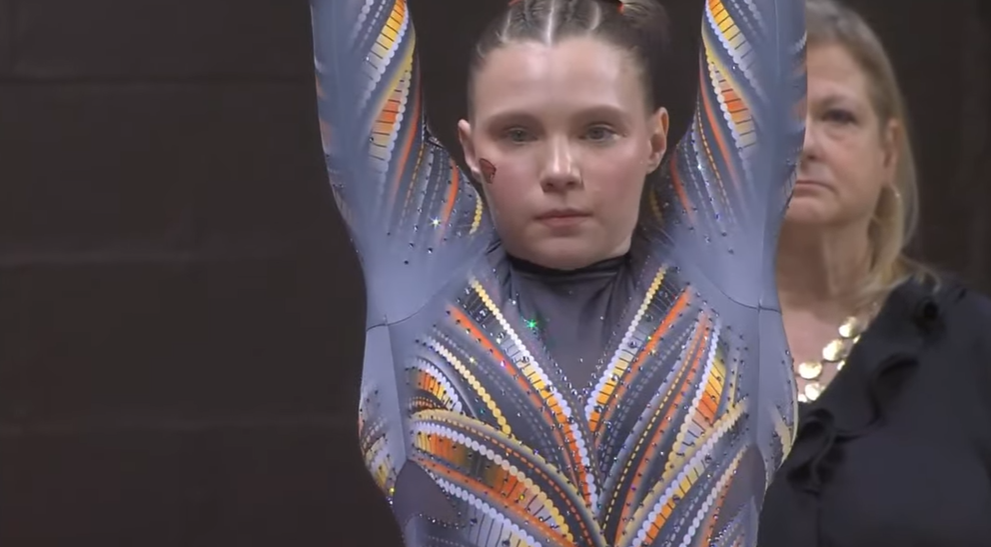More than just a personal achievement, Jade Carey’s March 2025 Instagram photo carousel with the caption “happy” subtly changed the perception of LGBTQ+ representation in professional sports. The pictures, which showed Carey with her girlfriend Aimee Sinacola, were simple but profoundly significant. The moment, which showed a side of Carey that had long been hidden, was elegant and strong, like a gymnast making a perfect landing.
Fans who were aware of Carey’s athletic ability found the relationship revelation to be both unexpected and expected. Although she had never previously discussed her sexual orientation in public, her decision to do so was incredibly liberating. It was just a sincere look into her life, given on her terms, rather than a well-planned announcement or a press-heavy coming out. Comments from other athletes, fans, and public figures reaffirmed the significance of such visibility, and the response was swift and overwhelmingly positive.
Jade Carey – Personal and Professional Information
| Field | Details |
|---|---|
| Full Name | Jade Ashtyn Carey |
| Date of Birth | May 27, 2000 |
| Nationality | American |
| Profession | Artistic Gymnast |
| Olympic Achievements | Gold – Floor (2020), Gold – Team (2024), Bronze – Vault (2024) |
| Collegiate Team | Oregon State University |
| Girlfriend | Aimee Sinacola |
| Public Reveal | Instagram Post, March 2025 |
| Reference | People Magazine |
As the Director of Creative Content for the University of Oregon’s athletic departments, Sinacola adds her own polished touch to their dynamic. She is more than just Carey’s companion; she is a storyteller who recognizes the value of carefully crafting moments. She responded to the post with warmth and candor, writing, “Soooooo happy,” which echoed the sentiment expressed by many. “When the notification came through and the public officially gets to know,” she captioned the screenshot when she reshared the post on TikTok, which is noteworthy.
The moment gains cultural significance at the nexus of personal happiness and public acknowledgment. Carey joined an increasing number of athletes who are changing the expectations surrounding identity in professional sports with this understated but impactful gesture. Collectively, these athletes are raising the bar for transparency and genuineness, much like gymnasts working in unison.

In the past, LGBTQ+ athletes’ visibility frequently came at a cost to their careers. Athletes were afraid that governing bodies might stop supporting them, fans would turn away, or sponsors would withdraw. However, this story has changed significantly in the last few years. People like Emma Twigg, Gus Kenworthy, and Megan Rapinoe have created opportunities for celebration as well as representation. Carey adds another beam to this increasingly supportive structure by walking that path in her own unique way.
She does so while maintaining her credibility. Her achievements, especially her gold medal in the 2020 Olympic floor exercise and her gold medal in the 2024 Paris team event, demonstrate her resilience under duress. Carey’s athletic profile is remarkably complete when you include a bronze in vault. These accomplishments demonstrate a caliber of performance that has won her the admiration of both teammates and judges.
Carey’s collegiate career has been noteworthy in addition to the medals. She is one of the most decorated gymnasts in the NCAA and competes for Oregon State University. Carey has established a benchmark that combines outstanding athleticism with a realistic sense of personal growth. She was recently recognized as OSU’s Female Athlete of the Year and named a finalist for the coveted AAI Award. Her ability to maintain her intense competitiveness while making room for happiness, love, and individuality says a lot about the direction elite sports are taking.
It’s particularly impressive how well Carey has managed to balance these aspects of her life. The images were just unscripted; they weren’t part of a planned campaign. The caption whispered rather than shouted. Nevertheless, the effect was indisputable. It serves as a reminder that big statements aren’t always necessary for progress. Sometimes the most profound resonance is found in the quiet authenticity.
This point is further supported by the responses of other gymnasts. Simone Biles, a pioneer in the field of mental health advocacy, made a joyful comment. Jordan Chiles, an Olympic teammate who was named one of TIME’s 2025 Women of the Year, also offered her support. These relationships represent a cultural trend toward greater inclusivity and go beyond simple friendships.
Younger athletes, especially those navigating their own identities in a high-pressure setting, can benefit greatly from this kind of openness. In the midst of the chaos of competition, expectations, and public life, Carey’s post serves as a digital lighthouse by providing a genuine, relatable example.
Being present is only one aspect of representation; another is confidence. It’s about witnessing someone just like you thrive—not in spite of who they are, but because they embrace it wholeheartedly. Carey’s story feels remarkably effective at shattering conventional narratives because it is told through a caption and a smile rather than through headlines.
Athletes like Carey are redefining what it means to lead in this age of perpetual connectivity, where social media posts frequently carry a greater emotional weight than press releases or interviews. They are modeling vulnerability, establishing standards, and assisting others in envisioning new possibilities—they are not merely carrying out routines.
Because of this, this moment is about much more than just revealing a relationship. It’s about the room it creates for dialogue, community, and transformation. A very clear message is conveyed when a top athlete bravely and casually shares who they love: you can be talented, honest, and tender all at once.


